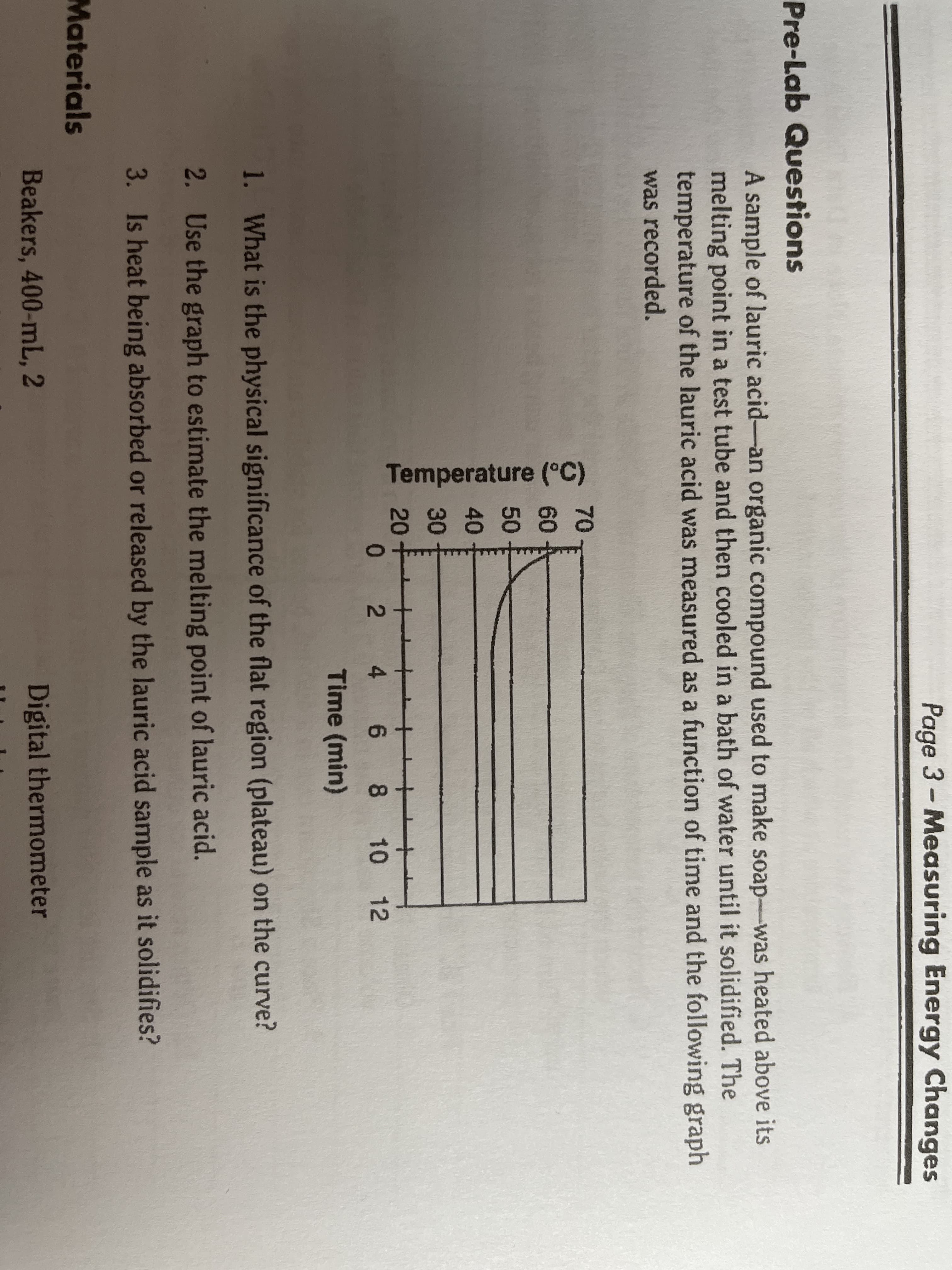Page 3- Measuring Energy Changes Pre-Lab Questions A sample of lauric acid-an organic compound used to make soap-was heated above its melting point in a test tube and then cooled in a bath of water until it solidified. The temperature of the lauric acid was measured as a function of time and the following graph was recorded. 70- 60- 50- 40 30 20- 0 2 4 6 8 10 12 Time (min) 1. What is the physical significance of the flat region (plateau) on the curve? 2. Use the graph to estimate the melting point of lauric acid. 3. Is heat being absorbed or released by the lauric acid sample as it solidifies? Materials Beakers, 400-mL, 2 Digital thermonmeter Temperature (°C)
Page 3- Measuring Energy Changes Pre-Lab Questions A sample of lauric acid-an organic compound used to make soap-was heated above its melting point in a test tube and then cooled in a bath of water until it solidified. The temperature of the lauric acid was measured as a function of time and the following graph was recorded. 70- 60- 50- 40 30 20- 0 2 4 6 8 10 12 Time (min) 1. What is the physical significance of the flat region (plateau) on the curve? 2. Use the graph to estimate the melting point of lauric acid. 3. Is heat being absorbed or released by the lauric acid sample as it solidifies? Materials Beakers, 400-mL, 2 Digital thermonmeter Temperature (°C)
General Chemistry - Standalone book (MindTap Course List)
11th Edition
ISBN:9781305580343
Author:Steven D. Gammon, Ebbing, Darrell Ebbing, Steven D., Darrell; Gammon, Darrell Ebbing; Steven D. Gammon, Darrell D.; Gammon, Ebbing; Steven D. Gammon; Darrell
Publisher:Steven D. Gammon, Ebbing, Darrell Ebbing, Steven D., Darrell; Gammon, Darrell Ebbing; Steven D. Gammon, Darrell D.; Gammon, Ebbing; Steven D. Gammon; Darrell
Chapter6: Thermochemisty
Section: Chapter Questions
Problem 6.134QP
Related questions
Question
Answer the following pre

Transcribed Image Text:Page 3- Measuring Energy Changes
Pre-Lab Questions
A sample of lauric acid-an organic compound used to make soap-was heated above its
melting point in a test tube and then cooled in a bath of water until it solidified. The
temperature of the lauric acid was measured as a function of time and the following graph
was recorded.
70-
60-
50-
40
30
20-
0 2 4 6 8 10 12
Time (min)
1. What is the physical significance of the flat region (plateau) on the curve?
2. Use the graph to estimate the melting point of lauric acid.
3. Is heat being absorbed or released by the lauric acid sample as it solidifies?
Materials
Beakers, 400-mL, 2
Digital thermonmeter
Temperature (°C)
Expert Solution
This question has been solved!
Explore an expertly crafted, step-by-step solution for a thorough understanding of key concepts.
This is a popular solution!
Trending now
This is a popular solution!
Step by step
Solved in 4 steps with 1 images

Knowledge Booster
Learn more about
Need a deep-dive on the concept behind this application? Look no further. Learn more about this topic, chemistry and related others by exploring similar questions and additional content below.Recommended textbooks for you

General Chemistry - Standalone book (MindTap Cour…
Chemistry
ISBN:
9781305580343
Author:
Steven D. Gammon, Ebbing, Darrell Ebbing, Steven D., Darrell; Gammon, Darrell Ebbing; Steven D. Gammon, Darrell D.; Gammon, Ebbing; Steven D. Gammon; Darrell
Publisher:
Cengage Learning

Chemistry: The Molecular Science
Chemistry
ISBN:
9781285199047
Author:
John W. Moore, Conrad L. Stanitski
Publisher:
Cengage Learning

Chemistry for Engineering Students
Chemistry
ISBN:
9781337398909
Author:
Lawrence S. Brown, Tom Holme
Publisher:
Cengage Learning

General Chemistry - Standalone book (MindTap Cour…
Chemistry
ISBN:
9781305580343
Author:
Steven D. Gammon, Ebbing, Darrell Ebbing, Steven D., Darrell; Gammon, Darrell Ebbing; Steven D. Gammon, Darrell D.; Gammon, Ebbing; Steven D. Gammon; Darrell
Publisher:
Cengage Learning

Chemistry: The Molecular Science
Chemistry
ISBN:
9781285199047
Author:
John W. Moore, Conrad L. Stanitski
Publisher:
Cengage Learning

Chemistry for Engineering Students
Chemistry
ISBN:
9781337398909
Author:
Lawrence S. Brown, Tom Holme
Publisher:
Cengage Learning

Chemistry & Chemical Reactivity
Chemistry
ISBN:
9781133949640
Author:
John C. Kotz, Paul M. Treichel, John Townsend, David Treichel
Publisher:
Cengage Learning

Chemistry & Chemical Reactivity
Chemistry
ISBN:
9781337399074
Author:
John C. Kotz, Paul M. Treichel, John Townsend, David Treichel
Publisher:
Cengage Learning

Chemistry: Principles and Practice
Chemistry
ISBN:
9780534420123
Author:
Daniel L. Reger, Scott R. Goode, David W. Ball, Edward Mercer
Publisher:
Cengage Learning